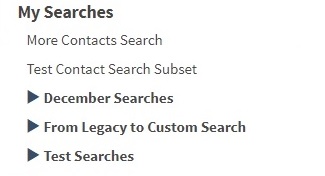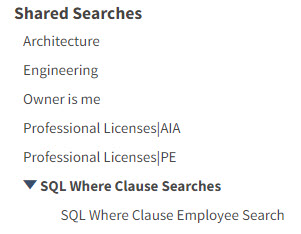Searches List
The Searches List includes all searches that are currently available for the active module. This list consists of different components, depending on the application from which you access it.
The Searches list may include any of the search types that are described below.
Saved Searches
![]()
You can access the
Saved Searches list from Search Navigation Controls feature at the top of most hub and application forms. All saved searches in this list are available for the active module and to which your security role has access. Click the to the right of the filter icon to display the
Saved Searches and
Record Selection panes.
to the right of the filter icon to display the
Saved Searches and
Record Selection panes.
For more information, see Search Quick Reference, Search Navigation Controls, and Components of a Search.
Quick Find

From the
Saved Searches pane, use this search field to enter part of a search's information, such as a name or number. If the information that you enter matches only one search in the database, an edit icon appears to the right of the search. Click
 to open the Edit Search dialog box. If the information produces more than one result, a list of all matching searches displays.
to open the Edit Search dialog box. If the information produces more than one result, a list of all matching searches displays.
For more information, see Use a Quick Find to Locate a Search.
Select Searches
This searches list is available on the Search dialog box and includes existing searches that are currently available for the active module and to which your security role has access.
Selection
If available, a
Selection search appears in the Saved Search control (![]() ) at the top of most Hub and application forms and also in the
Saved Searches list. The word
Selection denotes what is sometimes referred to as an ad hoc search. Only one ad hoc
Selection is available at any given time in the Saved Searches list and will remain unchanged until you either update it or create a new ad hoc selection search.
) at the top of most Hub and application forms and also in the
Saved Searches list. The word
Selection denotes what is sometimes referred to as an ad hoc search. Only one ad hoc
Selection is available at any given time in the Saved Searches list and will remain unchanged until you either update it or create a new ad hoc selection search.
For more information, see Select Records for an Ad Hoc Search and Edit an Ad Hoc Search Selection in Saved Search.
Standard Searches
Standard searches are predefined searches that are specific to the active module. You cannot modify them. Standard searches are usually listed at the top of the Saved Searches list. For example, in the Contacts hub, the standard searches are Active, All, and Mine.

For more information, see: Standard Searches .
My Searches (personal searches)
Personal searches are standard or advanced searches that you create to match your specific business requirements. Any search that you save for your role is listed under this heading. You can also use the Organize Searches feature to create custom folders in which to save and organize your personal searches.

For more information, see: Personal and Shared Searches, Build a Basic Search, Build an Advanced Search, and Organize Searches.
Shared Searches
Shared searches are standard or advanced searches that you create to match your business requirements and share with other roles. When you select additional roles in the Save For field on the Save Options dialog, the custom search is automatically added under this folder.

For more information, see: Personal and Shared Searches, Build a Basic Search, Build an Advanced Search, and Organize Searches.
SQL Where Clause Searches
SQL Where Clause searches are complex searches that you use to compare data and find records across multiple hubs, applications, and databases. Use the Advanced Settings feature to build these searches.

For more information, see: SQL Where Clause Searches and Run a SQL Where Clause Search.
Records or Saved Searches
Use the
Records or
Saved Searches list in Reporting to select a record or a saved search, or to open
 Search to create a new record search.
Search to create a new record search.
After you select records or searches, the Records Selected list appears as a filter and as a record search selection list in the following areas of the Reporting application:
- Favorites tab and Reports tab: The
Records or
Saved Searches
list is displayed as a filter in the Heading row. Use this to filter long lists of reports. Enter text or click
 to select a record search or click the
to select a record search or click the
 Search option.
Search option.
- On an individual report form: The
Records or
Saved Searches list is displayed on the title bar of the report for most reports. Enter text or click
 to select a record search or click the
to select a record search or click the
 Search option.
Search option.

 Search
Search
You can create a new search for hub records, report fields, and other application records. You use the New Search dialog box to refine your search criteria using either basic or advanced search features.
For more information, see: New Search Dialog Box, Personal and Shared Searches, Build a Basic Search, and Build an Advanced Search.